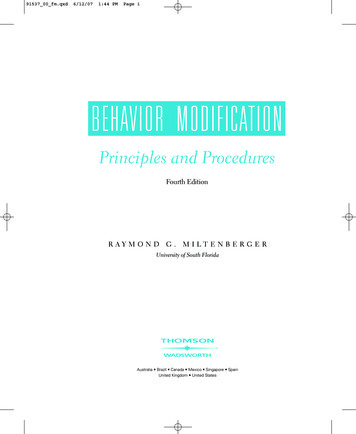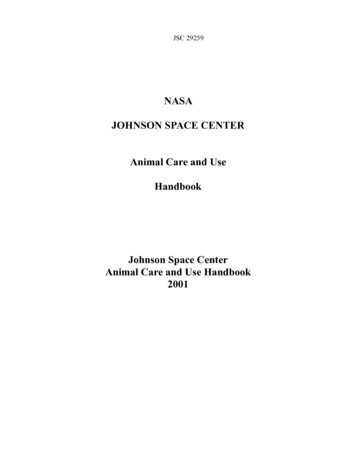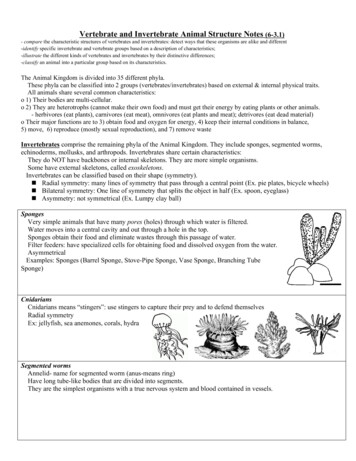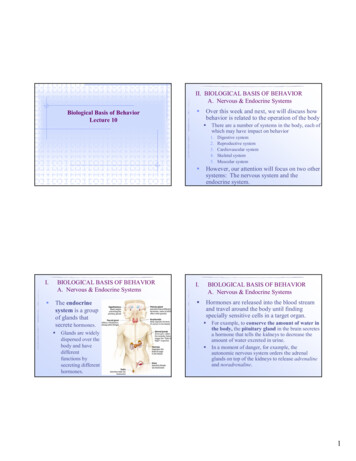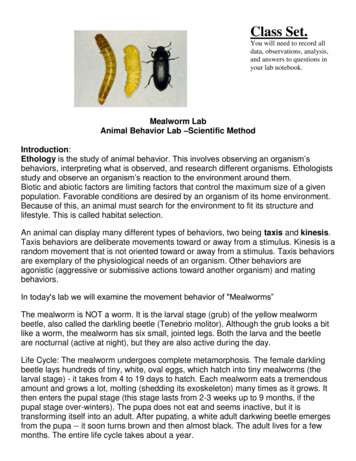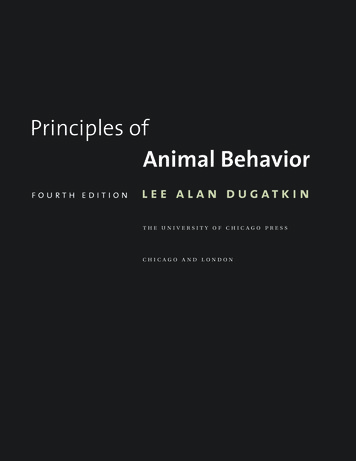
Transcription
Principles ofAnimal Behavior F o u r t h E d i t i o nL e e A l a n D u gat k i nThe University of Chicago PressChicago and London
Contents in Brief1Principles of Animal Behavior 12The Evolution of Behavior 203Hormones and Neurobiology 554Molecular Genetics and Development 875Learning 1116Cultural Transmission 1417Sexual Selection 1718Mating Systems 2029Kinship 23210Cooperation 26511Foraging 29712Antipredator Behavior 32713Communication 35514Habitat Selection, Territoriality, and Migration 38115Aggression 40716Play 43017Animal Personalities 452
1 Principles of Animal BehaviorTypes of Questions and Levels of AnalysisWhat Is Behavior?Three Foundations Natural Selection Individual Learning Cultural TransmissionConceptual, Theoretical, and Empirical Approaches Conceptual Approaches Theoretical Approaches Empirical ApproachesAn Overview of What Is to FollowInterview with Dr. E. O. WilsonI grew up in the heart of New York City. One animalthat my family and I encountered on a fairly regularbasis was the American cockroach (Periplanetaamericana) (Figure 1.1). Much to my mother’s chagrin,we seemed locked in a never- ending battle withthis creature—a battle that we usually lost. And weprobably lost because cockroaches have been subjectto this sort of problem—other organisms trying tokill them—for tens of millions of years. As a result,they have evolved an exquisite set of antipredatorbehaviors, which have had the side effect of makingthem a thorn in the side of modern apartmentdwellers.As a very young boy, I had, of course, neverheard of the scientific method—which theOxford English Dictionary defines as “scientificobservation, measurement, and experiment, and theformulation, testing, and modification of hypotheses.”Nevertheless, I was able to draw some inferences andformulate some hypotheses about cockroach behaviorby watching my mother put out the roach traps.First, it seemed to me that roaches liked to spendtheir time in dark places, and second, it appearedthat most roaches agreed on what was a good placefor roaches to be, as we kept putting the traps out inthe same place. These two thoughts on cockroachbehavior could easily be developed into the followinghypotheses: (1) cockroaches will choose dark placesover light places, and (2) roaches will return to thesame places over and over, rather than movingrandomly through their environment. Of course, asa child, I didn’t formally sit down and generate thesehypotheses, and I surely didn’t run the controlledexperiments that a scientist studying animal behaviorwould run to test these ideas, but I was nonethelessdabbling with scientific hypotheses in ethology—thestudy of animal behavior.Many people think like ethologists: from mymother, who understood roach behavior, to thefarmer who has detailed knowledge about pigs, cows,chickens, and other domesticated farm animals. Thegirl who works to train her dog, and the outdoorsmanwho, on his camping vacation, searches for someanimals and tries to avoid others, also think likeethologists. Indeed, humans have always thoughtand acted like ethologists. If our hunter- gathererancestors had not thought like ethologists, and hadn’t,for example, understood the prey they were tryingto catch, as well as the behavior of the predators thatwere trying to catch them, we wouldn’t be here today.The study of animal behavior appears to have beenso important that the earliest cave paintings tendedto depict animals. Early cave drawings might havefocused on any number of things, but apparentlyunderstanding something about the other life formssurrounding our ancestors was fundamental enoughthat they chose animals as the subjects for the earliestart. This focus on animals, and their behaviors,continued as humans began developing other typesof art. Artifacts from 4,000- year- old Minoan culturessuggest an advanced understanding of some aspectsof animal behavior: for example, a golden pendantfrom a Cretan cemetery that depicts two waspstransferring food to one another (Figure 1.2). Massetihypothesizes that this kind of knowledge of insectfood- sharing behavior could only have come frompeople who observed and studied the details of wasplife (Masseti, 2000). A similar sort of argument hasbeen made regarding a Minoan wall painting of“white antelopes.” This painting likely depicts gazellesin the early stages of an aggressive interaction (Figure1.3), and it is the sort of art that is associated withan in- depth knowledge of the subject in question(Voultsiadou and Tatolas, 2005).Spanning the millennia between ancient Cretancivilization and the present, thousands of amateurand professional naturalists have made some1
contribution to the study of animal behavior. Thesecontributions have enabled ethologists to draw on arich trove of information that has greatly expandedour understanding of animal behavior (Figure 1.4).Aristotle’s work on animals, for example, though 2,500years old, is a treasure chest of ethological tidbits.Indeed, with Aristotle’s books Physics and NaturalHistory of Animals, the field of natural history wasborn. In these and other works, Aristotle distinguishedamong 500 species of birds, mammals, and fish, andhe wrote entire tracts on the behavior of animals.In many ways, a course in animal behavior is whereall the other biology and psychology classes that youhave sat through up to this point in your academiccareer come together. Evolution, learning, genetics,molecular biology, development, neurobiology, andendocrinology congeal into one grand subject—animal behavior. The field of ethology is integrativein the true sense of the word, in that it combines theinsights of biologists, psychologists, anthropologists,and even mathematicians and economists.Types of Questions and Levels of AnalysisFigure 1.1. American cockroach. The American cockroach,often thought of as a pest in households around the world.(Photo credit: Thomas Won)Figure 1.2. Art captures animal behavior. This pendant fromthe Chrysolakkos funeral complex in Crete suggests that somemembers of this ancient culture had a detailed knowledge ofwasp behavior. (From Gianni Dagli Orti/The Art Archive at ArtResource, NY)2c h ap t e r o n eEthologists have asked questions about almost everyconceivable aspect of animal behavior—feeding,mating, fighting, and so on. At a broad level,ethologists pose four distinct types of questions, whichNiko Tinbergen outlined in a classic paper entitled “Onthe Aims and Methods of Ethology” (N. Tinbergen,1963; Bateson and Laland, 2013; Taborsky, 2014;Burkhardt, 2014; Dawkins, 2014; Strassmann, 2014;Lefebvre, 2015). These questions center on: Mechanism—What stimuli elicit behavior? Whatsort of neurobiological and hormonal changesoccur in response to, or in anticipation of, suchstimuli? Development—How does behavior change with theontogeny, or development, of an organism? Howdoes developmental variation affect behavior laterin life? Survival value—How does behavior affect survivaland reproduction? Evolutionary history—How does behaviorvary as a result of the evolutionary history, orphylogeny? When did a behavior first appear in theevolutionary history of the species under study?
Figure 1.3. Minoan wall paintings of “white antelopes.”The drawing may depict a “lateral intimidation” during anaggressive encounter between the animals. (From Masseti.Courtesy Ministry of Culture, Hellenic Republic)Thousands of studies have been undertaken oneach of these four types of questions. Tinbergen’s fourquestions can be captured in two different kinds ofanalyses—proximate analysis and ultimate analysis(Alcock and Sherman, 1994; Dewsbury, 1992, 1994;Hailman, 1982; Hogan, 1994; J. Huxley, 1942; Mayr, 1961;Orians, 1962; Reeve and Sherman, 1993; Haig, 2013).Proximate analysis focuses on immediate causes,whereas ultimate analysis centers on evolutionaryforces that have shaped a trait over time. As such,proximate analysis incorporates Tinbergen’s first twotypes of questions, and ultimate analysis covers thelatter two types (Figure 1.5). We could ask, for example:Why do some bird chicks peck at red stimuli butnot stimuli of other colors? Does red trigger a set ofneuronal responses that are not triggered otherwise?If so, exactly which neurons and when? These arequestions about proximate causation. An analysis atthe ultimate level, on the other hand, would ask: Whatselective forces in the birds’ evolutionary past wouldhave favored individuals that had responses to redstimuli? Was the color red associated with a particularfood source? Do other closely related bird speciesshow similar responses to red stimuli?Every chapter of this book examines animalbehavior from both proximate and ultimateperspectives.What Is Behavior?What do ethologists mean by the word behavior? Itturns out that this is not a trivial question, and it isFigure 1.4. Images from a cave. A drawing of a herd ofantelope found on the walls of a cave at Dunhuang, China.(Photo credit: Jean Clottes)one that ethologists have grappled with for sometime. Early on, ethologists like Tinbergen definedbehavior as “the total movements made by the intactanimal,” but that definition seems far too general,incorporating almost everything an animal does. Butif a definition proposed by Tinbergen—who shareda Nobel Prize as a founder of the study of animalbehavior—doesn’t work, how can a satisfactorydefinition be achieved?One solution is to survey ethologists to get adiscipline- wide view of the way the term behavioris employed. In a review paper on definitions ofbehavior, Daniel Levitis and his colleagues surveyed174 members of three professional societies that focuson behavior to try to understand what researchersmean when they used the term behavior (Levitis et al.,2009). What they found was much variation amongethologists on how behavior should be defined. Basedon their survey results, Levitis and his colleaguesargued that many of the definitions that ethologistsuse can be captured by a few published, but quitedated, definitions already in the literature. Theseinclude Tinbergen’s 1952 definition of behavior, as wellas the following: “Externally visible activity of an animal, in whicha coordinated pattern of sensory, motor andassociated neural activity responds to changingexternal or internal conditions” (Beck et al., 1981). “A response to external and internal stimuli,following integration of sensory, neural, endocrine,and effector components. Behavior has a geneticbasis, hence is subject to natural selection, and itPrinciples of Animal Behavior3
Figure 1.5. Tinbergen’sfour types of questions.A diagrammatic representationof the four different types ofquestions asked by ethologists.Two of these types ofquestions are proximateand two are ultimate. commonly can be modified through experience”(Starr and Taggart, 1992).“Observable activity of an organism; anything anorganism does that involves action and/or responseto stimulation” (R. Wallace et al., 1991).“Behavior can be defined as the way an organismresponds to stimulation” (D. Davis, 1966).“What an animal does” (Raven and Johnson, 1989).“All observable or otherwise measurable muscularand secretory responses (or lack thereof in somecases) and related phenomena such as changesin blood flow and surface pigments in responseto changes in an animal’s internal and externalenvironment” (Grier and Burk, 1992).“Behavior is defined as the expression of the activityof the nervous system” (Hogan, 2015).Each of these definitions has its pluses and minuses.If “behavior has a genetic basis,” as it certainly doesin many instances, does that mean that we shouldexclude all actions that have not been studied from agenetic perspective when we speak of behavior? Surelynot. For any of the definitions above we could poseequally strong challenges. That said, I needed to adopta consistent definition of behavior in this book, and Iwill use one that is a slight modification of a suggestionby Levitis and his colleagues—namely, that behavior isthe coordinated responses of whole living organismsto internal and/or external stimuli. This definitionis appropriate for a number of reasons (all of whichare admittedly somewhat subjective): (1) it seems tocapture what most modern ethologists and behavioralecologists mean when they use the term behavior,(2) it works fairly well for the behaviors covered indetail in chapters 6–17 of this book, and (3) it makesan important distinction between organism andorgan. What this third point means is that, as Levitisand his colleagues note, sweating in response toincreasing body temperature is not generally thoughtof as a behavior per se. But when an animal moves to4c h ap t e r o n ethe shade in response to heat and its own sweating,most ethologists would agree that this is a behavioralresponse.Three FoundationsIncredible tales and fascinating natural history make atextbook on animal behavior different from a textbookon organic chemistry or molecular genetics. Whatlinks animal behavior to all scientific endeavors,however, is a structured system for developing andtesting falsifiable hypotheses and a bedrock set offoundations on which such hypotheses can be built.Throughout this book, the force of natural selection,the ability of animals to learn, and the power oftransmitting learned information to others (culturaltransmission) will serve as the foundations uponwhich we build our approach to ethology.In his classic, On the Origin of Species—widelyregarded as the most important biology book everwritten—Charles Darwin laid out general argumentsfor how evolutionary change has shaped the diversityof life and how the primary engine of that change isa process that he dubbed natural selection (Darwin,1859). In a nutshell, Darwin argued that any traitthat could be transmitted across generations (i.e., isheritable) and provided an animal with some sort ofreproductive advantage over others in its populationwould be favored by natural selection. Naturalselection is, then, the process whereby traits thatconfer the highest relative reproductive success ontheir bearers increase in frequency over generations.Whereas natural selection changes the frequencyof different behaviors over the course of manygenerations, individual learning can alter thefrequency of behaviors displayed within the lifetimeof an organism. Animals learn about everythingfrom food and shelter to predators and familialrelationships. If we study how learning affects
behavior within the lifetime of an organism, we arestudying learning from a proximate perspective. Ifwe study how natural selection affects the ability ofanimals to learn, we are approaching learning froman ultimate perspective. Later in this chapter we willexamine a study on learning and foraging (feeding)behavior in grasshoppers. When we ask what sort ofcues grasshoppers use to learn where to forage, weare addressing learning from a proximate perspective.When we examine how a grasshopper’s ability to learnabout food sources affects its reproductive success,and how selection might favor such abilities, we arestudying learning from an ultimate perspective.Cultural transmission also affects the type ofbehavior animals exhibit and the frequency withwhich behaviors occur. While definitions vary widelyacross disciplines, this book uses the term culturaltransmission to mean a transmission system inwhich animals learn through various forms of sociallearning. Cultural transmission can allow newlyacquired traits to spread through populations at a veryquick rate, as well as permit the rapid transmissionof information across generations. As with individuallearning, natural selection can also act on animals’ability to transmit, acquire, and act on culturallytransmitted information.NATURAL SELECTIONDarwin recognized that his theory of naturalselection applied to behavioral traits as well asmorphological, anatomical, and developmental traits.Indeed, morphological traits are often the physicalunderpinning for the production of behavior, somorphology and behavior are linked at many levels.More detail about this linkage is provided below andthroughout the book, but for the moment, the keypoint is that Darwin’s ideas on evolution, naturalselection, and behavior were revolutionary, andethology today would look very different were it notfor the ideas that Darwin set forth in On the Origin ofSpecies. A fascinating example involving mating andparasites in Hawaiian crickets illustrates how naturalselection operates on animal behavior in the wild.In the evening on the Hawaiian Islands, malecrickets sing to attract their mates. This “singing”results when the male cricket rapidly moves thesmooth scraper on the front of one wing against theserrated file on the other wing. Females cue in on malesongs, and they typically will not mate with males thatdo not produce songs. But as with many behavioraltraits associated with attracting mates, male singingis not cost free. Just as females are attracted to malesong, so too are potentially dangerous parasites (Zukand Kolluru, 1998).Marlene Zuk and her colleagues have been studyingthis trade- off in male song production—betweenattracting females and attracting parasites—in thefield cricket Teleogryllus oceanicus (Zuk et al., 2006).These crickets are parasitized by the fly Ormiaochracea, who are attracted to singing males. If a flyfinds a singing cricket, it lays its eggs on the cricket,and then the fly larvae burrow their way into thecricket and grow. Emergence of the flies from thelarvae kills the cricket.Parasitic flies are found on three of the HawaiianIslands—Oahu, Hawaii, and Kauai—that are alsohome to T. oceanicus. The flies are most common onthe island of Kauai, where 30 percent of the cricketsare parasitized. Zuk and her team have been studyingthe relationship between crickets and parasitic fliessince 1991, and over time, they noted what appearedto be a significant decline in the cricket populationon Kauai. Over the years, they heard fewer and fewersinging males on this island, and they assumed thatthe parasitic fly was slowly causing the extinction ofT. oceanicus on Kauai. Indeed, in 2003 they heard onlya single male singing. But when they got down on theirhands and knees and searched for crickets, Zuk andher team found T. oceanicus in abundance. How couldthey explain these seemingly contradictory findings?What Zuk and her team found was that most ofthe males on Kauai had modified wings that were notcapable of producing song (Figure 1.6). The file sectionof the wings of these Kauai males (called “flatwingmales”) was significantly reduced compared to that ofnormal males, and its position on the wings changed,such that song production was no longer possible.These changes were likely the result of mutationsof one, or possibly, a few genes associated withwing development and song production. Once suchmutations arose, natural selection should stronglyfavor such flatwing males, that would virtually neverbe parasitized by very dangerous flies. Or should it?Flatwing males should have a huge survivaladvantage, but they might also be at a disadvantagewith respect to attracting females that hone inon singing males as potential mates. For flatwingmales to be favored by natural selection, they mustPrinciples of Animal Behavior5
Figure 1.6. Natural selection incrickets. Marlene Zuk and her colleagueshave been studying the field cricketTeleogryllus oceanicus. Pictured here are(A) a field cricket with normal wings (thearrow points to the file on its outstretchedwing); (B) a field cricket with flat wings, inwhich the file section on the outstretchedwing has evolved to a much smaller sizeand is visible only under a high- poweredmicroscope; and (C) fly larvae in aparasitized cricket. (Photo credits:Robin Tinghitella; John Rotenberry)ABCsomehow still secure opportunities to mate. Zuk andher colleagues hypothesized that flatwing males dothis by staying near the handful of singing males stillon Kauai, and mating with females as they approachsingers. This sort of “satellite” male mating behaviorhas been seen in many T. oceanicus populations(Tinghitella et al., 2009). To test their hypothesis,they collected 133 Kauai males—121 of which wereflatwings, and 12 of which were singers. They thenused “playback” experiments, in which male songswere broadcast over loudspeakers. What they foundwas that flatwing males were drawn to playbacksmore strongly than normal males, suggesting thatflatwing males stay near singer males in order tosecure chances to mate with females drawn in by thesingers. With both a huge survival advantage and thecontinued ability to obtain matings, flatwing males6c h ap t e r o n eshould be strongly favored by natural selection. Andindeed, Zuk and her colleagues suggest that themutation(s) leading to the loss of song occurred onlyfifteen to twenty generations ago and has quicklyincreased in frequency, so that now most males onKauai are flatwing males (Rotenberry et al., 2015;Rotenberry and Zuk, 2016). Remarkably, on the nearbyHawaiian island of Oahu, Zuk and her team havefound an independent, parallel, case of the evolutionof flatwing males, and they are currently trackingthe success of flatwings on that island (Pascoalet al., 2015). We will delve more deeply in this sort ofconvergent evolution in subsequent chapters.As a second example of natural selection actingon animal behavior, let’s examine how individuals insocial groups respond to strangers. For animals thatlive in stable groups, strangers—unknown individualsfrom outside your group—represent a threat. Suchindividuals may compete for scarce resources(including food and mates), disrupt group dynamicsthat have long been in place, and so on. Because ofsuch costs, ethologists have examined whether animalsfrom group- living species display xenophobia—a fearof strangers. In particular, ethologists hypothesize thatxenophobia may be especially strong when resourcesare scarce, since competition for such resources will beintense then, and keeping strangers away may have anespecially strong impact on the lifetime reproductivesuccess of group members.To examine the effect of resource scarcity on the
evolution of xenophobia, Andrew Spinks and hiscolleagues examined xenophobia in the commonmole rat (Cryptomys hottentotus) (Spinks et al., 1998;Figure 1.7). Common mole rats live in South Africain underground colonies made up of two to fourteenindividuals. They are an ideal species in which toexamine xenophobia and its possible connectionto resource availability for two reasons: First, allpopulations of common mole rats are “tightly knit”in the sense that each group typically has a single pairof breeders that produce most of the offspring in acolony, which means that most group members aregenetic relatives (J. M. Bishop et al., 2004). Second,populations of common mole rats differ in terms ofthe amount of resources in their environments. Somecommon mole rat populations live in moderatelymoist (mesic) environments that present only mildresource limitations, while other populations live indry (arid) environments and face intense limitationson their resources. Variation in resource availabilitybetween arid and mesic populations is largely dueto the fact that mesic environments have about fourtimes as much rainfall as arid environments.Spinks and his colleagues examined whetherpopulations from arid areas were more xenophobicthan those from mesic environments, as one mightpredict based on the discussion above about naturalselection, resources, and xenophobia. To do so, theyconducted 206 trials in which two mole rats—onefrom the arid and one from the mesic environment—were placed together, and aggression was recorded.When the pair of individuals were both males orboth females, aggression toward such strangerswas much more pronounced in the common molerats from the arid environment, where resourceswere limited, than it was in the common mole ratsfrom the mesic environment. This result was nota function of individuals from arid populationsjust being more aggressive in general. Controlexperiments demonstrated that when two individualsthat knew each other from the arid population weretested together, aggression disappeared—it wasthe identification of a stranger that initiated theaggression. Natural selection has favored strongerxenophobic responses in common mole rats whoseresources are more limited.The ecology of common mole rats is such thatsome individuals leave their home colony to find amate. What this means is that some strangers thatFigure 1.7. Common mole rat. This xenophobic common molerat (Cryptomys hottentotus) is showing an aggressive stancein response to a stranger. (Photo credit: Chris and Tilde Stuart/FLPA/Minden Pictures)are encountered by members of a social group arepotential mates, and perhaps worth tolerating. Naturalselection then should not simply favor all xenophobia,but a xenophobia that is sensitive to the sex of thestranger. In trials in which the two individuals testedwere a male and a female, Spinks and his colleaguesfound that while aggression was still observedin the low- resource, arid population, the level ofaggression decreased dramatically when comparedwith aggression in same- sex interactions (Figure 1.8).Natural selection has favored common mole rats thattemper their fear of strangers as a function of bothwhere they live and the sex of the strangers.INDIVIDUAL LEARNINGAs chapter 5 explores in much greater detail,individual learning can take many forms. Let’s beginour discussion by considering a hypothetical caseof learning and mate choice. Suppose that we arestudying a species in which female birds mate withnumerous males throughout the course of theirlifetime and females are able to keep track of howmany chicks fledged their nest when they mated withmale 1, male 2, male 3, and so forth. If we found thatfemales changed their mating behavior as a result ofdirect personal experience, preferring to mate withmales that fathered the most successful fledglings,such results would suggest that learning had changedthe behavior of an animal within the course of itslifetime (Figure 1.9).The learning example above highlights animportant relationship between learning and naturalPrinciples of Animal Behavior7
Figure 1.8. Xenophobia incommon mole rats. Spinks andhis colleagues found that molerats from an arid environment(green bars) were more likely toreject a potential partner fromtheir own population than weremole rats from a resource- richmesic environment (orangebars). (From Spinks et al., 1998,p. 357)Figure 1.9. A role forlearning. Imagine a femalethat mates with different malesover the course of time. Such afemale might learn which maleis a good mate by keeping trackof the number of eggs she laidafter mating with each male.selection. In our example, females changed theirpreference for mates as a result of prior experience,and so learning affected mating behavior within ageneration. But just because the use of a behavior ischanging within the course of an individual’s lifetimedoes not mean that natural selection is not occurring.It is certainly possible for natural selection to operateon the ability to learn. That is, natural selection mightfavor the ability to learn which individuals make goodmates over, say, the lack of such an ability. If this werethe case in the example above, learning would changebehaviors within a generation, and natural selectionmight change the frequency of different learning rulesacross generations.Learning and natural selection are tied together8c h ap t e r o n enicely in Reuven Dukas and Elizabeth Bernays’singenious experiment examining the fitnessconsequences of learning in insects (Dukas andBernays, 2000). While learning in insects is welldocumented, documenting the potential fitness- related benefits of learning has proved to be moredifficult (Dukas, 2006). To address the question oflearning- related benefits directly, Dukas and Bernaysexamined the potential fitness- related benefits oflearning in the context of feeding behavior in thegrasshopper, Schistocerca americana (Figure 1.10).In their experiment, they placed two food dishes ina grasshopper’s cage. The food in one dish provideda “balanced diet (b)” that included proteins andcarbohydrates—a diet that promotes maximal growth
Figure 1.10. Some components of foraging in grasshoppersare learned. Schistocerca americana grasshoppers learnedto associate various cues with food sources. (Photo credit:American bird grasshopper, Maria de Bruyn; https://mybeautifulworldblog.com/)rates in S. americana. The food in a second dish waslabeled a “deficient diet (d).” This diet containedflavoring and protein, but no carbohydrates. Specificodors and colors were associated with each of thetwo diets. Diets were supplemented with either citral(odor 1) or coumarin (odor 2), and food dishes wereplaced near either a brown- colored card (color 1)or a green- colored card (color 2). This created anopportunity for the grasshoppers to pair balanced anddeficient diets with both odor cues and color cues.Dukas and Bernays’s experiment contained a“learning” treatment and a “random” treatment(Figure 1.11). In the learning treatment, the balanceddiet dish was always paired with one specific odor andone specific colored card. Twice a day, a grasshopperwas presented with the two food dishes and allowedto choose one from which to feed. For example,grasshopper A might be placed in a cage in which thebalanced diet was always paired with the brown colorand the odor of coumarin. In principle, grasshopper Acould learn that together the cues coumarin andbrown color are associated with a food dish thatcontained the balanced diet. In contrast, in therandom treatment, the odor and color cues associatedwith the balanced diet were randomly assigned. Forexample, in the morning, grasshopper B might havethe balanced diet dish paired with the color greenand the odor of coumarin, but in the afternoon, thebalanced diet
contribution to the study of animal behavior. These contributions have enabled ethologists to draw on a rich trove of information that has greatly expanded our understanding of animal behavior (Figure 1.4). Aristotle’s work on animals, for example, though 2,5


